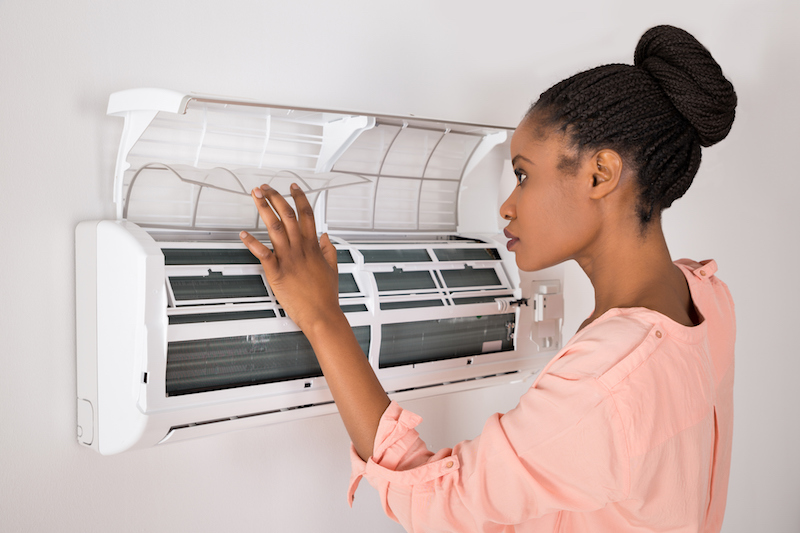
You shouldn’t have to give up comfort or drain your wallet to keep your home at a pleasant setting during muggy weather.
But what is the best temperature, exactly? We discuss recommendations from energy specialists so you can find the best setting for your home.
Here’s what we suggest for the most energy-efficient setting for air conditioning in Marshalltown.
Recommended Thermostat Settings for Summer
Most households find using the thermostat at 72-73 degrees provides ideal comfort. However, if there’s a sizeable difference between your indoor and outside temps, your electricity bills will be bigger.
This is our advice based on the U.S. Department of Energy (DOE) and ENERGY STAR®.
While at home: 78 degrees. While that sounds too high, there are approaches you can keep your residence cool without having the air conditioning on frequently.
Keeping windows and window treatments down during the day keeps cool air where it needs to be—inside. Some window treatments, such as honeycomb shades or plantation shutters, are made to give more insulation and improved energy conservation.
If you have ceiling fans in your residence, the DOE says you can raise thermostat temps about 4 degrees warmer without compromising comfort. That’s because they cool through a windchill effect. Since they cool people, not areas, switch them off when you exit a room.
If 78 degrees still appears too warm at first glance, try conducting a trial for about a week. Get started by upping your thermostat to 78 degrees while you’re home. Then, steadily turn it down while following the ideas above. You could be astonished at how comfortable you feel at a hotter temperature setting.
While away: 88 degrees. There’s no reason to keep the AC on all day while your home is vacant. Turning the setting 7–10 degrees hotter can save you an estimated 5–15% on your AC expenses, according to the DOE.
When you arrive home, don’t be tempted to set your thermostat colder than 78 to cool your house more quickly. This isn’t useful and typically produces a more expensive air conditioner bill.
A programmable thermostat is a helpful approach to keep your temperature controlled, but you have to set programs. If you don’t utilize programs, you might forget to change the set temperature when you leave.
If you want a handy solution, think over getting a smart thermostat. This thermostat connects with your phone, so it is aware when you’re at home and when you’re out. Then it automatically adjusts temperature settings for maximum savings. How much exactly? Typically $180 each year on heating and cooling, according to ENERGY STAR.
Another perk of installing a smart thermostat? You can use your phone to keep an eye on and change temperature settings from nearly anywhere.
While sleeping: Around 70 degrees. While ENERGY STAR suggests 82 degrees, that may be unbearable for many families. Many people sleep better when their sleeping space is cold, so that’s why the National Sleep Foundation suggests 60–67 degrees. But that may be too chilly, depending on your clothing and blanket preference.
We suggest trying an equivalent test over a week, putting your temperature higher and progressively decreasing it to pinpoint the best temperature for your residence. On cool nights, you may learn keeping windows open at night and relying on a ceiling fan is a better idea than operating the air conditioner.
More Methods to Use Less Energy During Warm Weather
There are other methods you can conserve money on cooling bills throughout hot weather.
- Upgrade to an energy-efficient cooling system. Central air conditioners only are effective for about 12–15 years and become less efficient as they become older. An updated air conditioner can keep your residence comfier while keeping electricity bills low.
- Schedule regular air conditioner tune-ups. Annual air conditioner maintenance keeps your equipment working smoothly and could help it run at better efficiency. It could also help extend its life expectancy, since it helps techs to pinpoint small issues before they cause a major meltdown.
- Replace air filters frequently. Use manufacturer instructions for replacing your air filter. A dusty filter can lead to your system short cycling, or run too much, and drive up your energy.
- Check attic insulation levels. Just about 90% of homes in the United States don’t have enough insulation, according to the Insulation Institute. The majority of southern climates need 13–14” of attic insulation, while northern climates should have 16–18”.
- Have your ductwork examined. Ductwork that has loosened over time can let conditioned air into your attic, walls or crawl space. This can result in major comfort troubles in your home, like hot and cold spots.
- Seal cracks, doors and windows. Keep muggy air in its place by plugging holes. You can also caulk or weather strip doors to keep more conditioned air inside.
Conserve More Energy This Summer with B & G HVAC
If you need to save more energy during hot weather, our B & G HVAC experts can provide assistance. Reach us at 641-316-3360 or contact us online for more information about our energy-saving cooling options.


